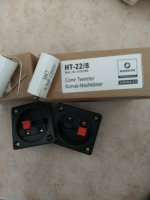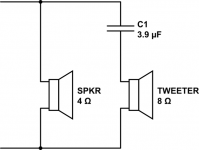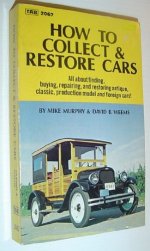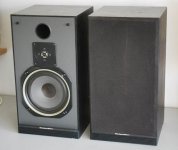AFAIK, if you want a cheap and cheerful cone tweeter, the Monacor HT-22/8 is a better performer than either Visaton, which have their quirks. Being a distributor, Monacor carry all kinds of tweeters, including some domes with waveguide. I would not advise on using a dome without at least a shallow waveguide, they are really hard to match to anything dispersion wise.
Cone tweeters basically come with a waveguide built right in, but they've got an efficiency problem instead.
Cone tweeters basically come with a waveguide built right in, but they've got an efficiency problem instead.
It's been a long and convoluted thread, sgrossklass!My "very cheap and cheerful" option employs the HT-22/8 | Monacor UK
AFAIK, if you want a cheap and cheerful cone tweeter, the Monacor HT-22/8 is a better performer than either Visaton
Thanks for the input
As Galu mentioned it has been a bit of a ride this thread haha.. I had ordered the HT-22s but they arrived damaged and then the price rose almost 2x the price (im guessing the amazon algorithm trying to screw me over), and so far I haven't found a distributor that doesn't charge more in shipping to Italy than the actual speakers, or too high price tag on the monacors.
I trust Galu's opinion on those monacor, it's just been tough to get them where I am
Of those choices, I would definitely go for the dome tweeter.
Protect it with a 3.9uF film capacitor.
Ok cool, thanks!
Maybe finally things will get going
What do you mean by protecting them? Does it mean that will be the cross over?
Protecting means stopping the bass frequencies from reaching the tweeter. That is what the capacitor does....we can use a simple first-order, high-pass crossover on the tweeter. This consists of a single capacitor.
Hey Galu!
Guess what, good news.... I found the Monacors!! and in the same website I found the capacitors too

I was about to give up and a friend of a friend (true story just met him about 2 weeks ago hehe) recommended a site, but they said to wait to see if those arrived this month and they did!
So I'm gonna order them and then we can finally (again) move on hahaha
Quick question, I was thinking of testing the set up in the current box by plugging the hole of the tweeter (I think you mentioned something like this before), instead of waiting until I actually build the new box?
I ask because there is a lockdown here and we can't move, hence cant go to look pick up materials until lockdown ends, and I wont be able to wait to test it out. And that way if something sounds odd its easier to just "troubleshoot" in the old current box.
Given that the new enclosure would be basically a replica, I would guess the result would be transferable right?
Thanks!
Guess what, good news.... I found the Monacors!! and in the same website I found the capacitors too

I was about to give up and a friend of a friend (true story just met him about 2 weeks ago hehe) recommended a site, but they said to wait to see if those arrived this month and they did!
So I'm gonna order them and then we can finally (again) move on hahaha
Quick question, I was thinking of testing the set up in the current box by plugging the hole of the tweeter (I think you mentioned something like this before), instead of waiting until I actually build the new box?
I ask because there is a lockdown here and we can't move, hence cant go to look pick up materials until lockdown ends, and I wont be able to wait to test it out. And that way if something sounds odd its easier to just "troubleshoot" in the old current box.
Given that the new enclosure would be basically a replica, I would guess the result would be transferable right?
Thanks!
Last edited:
Protecting means stopping the bass frequencies from reaching the tweeter. That is what the capacitor does.
Ah ok cool, thanks! Btw as I mentioned above, I found those Polyester Capacitors (3,3 µF) you recommended for protecting* the Monacors
Yes, and it's a sensible idea to test out the new driver combination in the old enclosures before committing yourself to spending time & money on building new enclosures.Given that the new enclosure would be basically a replica, I would guess the result would be transferable right?
Hey Galu!
Look what the cat dragged in today! Now we are back in business!
Now we are back in business!
So what is the plan with hooking this up? In the air like the sanyos were before just to test, or is there another way you have in mind?
Also is there some specific testing I should/could do for the capacitors, just to see if they are ok before soldering (to see if I should return/replace them)? Or are they tested while connected to the speakers?
I have my multimeter now if that's useful for this
Look what the cat dragged in today!
So what is the plan with hooking this up? In the air like the sanyos were before just to test, or is there another way you have in mind?
Also is there some specific testing I should/could do for the capacitors, just to see if they are ok before soldering (to see if I should return/replace them)? Or are they tested while connected to the speakers?
I have my multimeter now if that's useful for this
Attachments
There's absolutely no need to test the capacitors. No way will they be faulty!
Run twin flex from the input terminal posts to the woofer terminals then from the woofer to the tweeter, but include the capacitor in the positive wire going to the tweeter. You could simply tape the capacitor securely to the woofer basket in order to support it.
Observe polarity i.e. red to red (+) and black to black (-).
The circuit diagram is shown in the attachment (ignore the values shown), but the physical wiring is as I've described.
Run twin flex from the input terminal posts to the woofer terminals then from the woofer to the tweeter, but include the capacitor in the positive wire going to the tweeter. You could simply tape the capacitor securely to the woofer basket in order to support it.
Observe polarity i.e. red to red (+) and black to black (-).
The circuit diagram is shown in the attachment (ignore the values shown), but the physical wiring is as I've described.
Attachments
Ok cool, sounds simple enough, thanks!! 

 Had to google what was twin flex hahaha (never heard cables being called like that
Had to google what was twin flex hahaha (never heard cables being called like that  ).
).
So basically the wiring/soldering I do it already as its going to be in "the end product, and then once I do the new box I just move it al together right? Or is this just a test setup/dry run?
Also, what do I look for in the sound as far as to tell if something is wrong? I can think about the obvious like over-powering highs compared to lows and vicevesa when listening to music, and distortions; but is there some specific tests or things I should look out for to see if we need to do something else?

 Had to google what was twin flex hahaha (never heard cables being called like that
Had to google what was twin flex hahaha (never heard cables being called like that So basically the wiring/soldering I do it already as its going to be in "the end product, and then once I do the new box I just move it al together right? Or is this just a test setup/dry run?
Also, what do I look for in the sound as far as to tell if something is wrong? I can think about the obvious like over-powering highs compared to lows and vicevesa when listening to music, and distortions; but is there some specific tests or things I should look out for to see if we need to do something else?
1. I'll let you decide that. Do what you think is practicable.1. ...once I do the new box I just move it al together right? Or is this just a test setup/dry run?
2. Also, what do I look for in the sound as far as to tell if something is wrong? I can think about the obvious like over-powering highs compared to lows ... but is there some specific tests or things I should look out for to see if we need to do something else?
2. No specific tests are required at this level of refinement, just use your ears!
It's possible that the tweeter will be louder than the woofer, but we'll cross that bridge if we come to it.
It's a term that's been long used in the UK.Had to google what was twin flex hahaha (never heard cables being called like that).
The name 'flex' is short for 'flexible cable' and, of course, 'twin flex' is two core flexible cable as commonly used to wire up speakers.
No specific tests are required at this level of refinement, just use your ears!
It's possible that the tweeter will be louder than the woofer, but we'll cross that bridge if we come to it.
Ok cool! I will be giving this a go this weekend and I will update you
Just a quick last question, provided it all works ok, can I also ask you a couple things about the box build, or should I make a new thread for it?
Ask away, but it might be a good idea to do some homework first.
There's lots of information on building speaker enclosures on the interweb e.g. DIY Audio Speaker Box Building Guide
I recommend this book: Designing, Building, and Testing Your Own Speaker System with Projects by David B. Weems (1-Jan-1997) Paperback: Amazon.co.uk: Books A good buy if you can source it locally.
You will find the book to be a valuable source of reference as you progress in your loudspeaker construction hobby.
There's lots of information on building speaker enclosures on the interweb e.g. DIY Audio Speaker Box Building Guide
I recommend this book: Designing, Building, and Testing Your Own Speaker System with Projects by David B. Weems (1-Jan-1997) Paperback: Amazon.co.uk: Books A good buy if you can source it locally.
You will find the book to be a valuable source of reference as you progress in your loudspeaker construction hobby.
> I recommend this book:
Weems in general is OK, perhaps the best readily-available basic loudspeaker book.
There are *several* titles with more or less in each one. I'd take Galu's suggestion but if it is not readily available take any Weems *speaker* book(*).
While searching I saw some "PDF" copies. The first one I poked-at was clearly NOT going to give me a PDF but maybe an infection.
(*) I did not know this. Weems wrote on goats, high-voltage, and historical fiction: "a young Scottish lord is kidnapped ...to place him in colonial America as a bond servant".

Weems in general is OK, perhaps the best readily-available basic loudspeaker book.
There are *several* titles with more or less in each one. I'd take Galu's suggestion but if it is not readily available take any Weems *speaker* book(*).
While searching I saw some "PDF" copies. The first one I poked-at was clearly NOT going to give me a PDF but maybe an infection.
(*) I did not know this. Weems wrote on goats, high-voltage, and historical fiction: "a young Scottish lord is kidnapped ...to place him in colonial America as a bond servant".

Attachments
Thanks both for the recommendations 
Yes, I am reading some articles I have been "collecting" (including your link) and learning a bunch, but there are a couple things that I don't see mentioned and I am wondering if they are "known/proven details" that don't get repeated much or if they are more like a "traditional"/conventionel preference.
So I'm not gonna go all crazy with re-designing, I'm basically gonna recreate with small modification/improvements, since 1 driver is out. Small things like less height and deeper box, and like what you mentioned once: to center the port.
So the question I had was related more to placement or alignment of the drivers on the front baffle. The "traditional" way is top to bottom: high-mid-low-port; or high-low-port. But what if its done high-port-low? Would that be ok, considering that the center of the drivers would be "within the length of a wave at the crossover frequency"? I have also seen some with low-high-port, so I wonder if apart from the distance between speakers and aligning the highs to the listeners ears, does it make a difference?
Also, related to the above and the port, apart from keeping the distance of 1 diameter from the edges of the port to anything else in the box, does placing matter? From what I understand the port kinda acts like a "second" woofer or well an amplifier of certain frequencies (the ones its tuned for), and also I have read that its good practice to raise low freq. drivers like woofers/subs to "even-up" the pressure within the room, "spreading" those freq. more evenly. So given this, would a port-high-low placement be a good idea (or even the previously mentioned low-high port)?
I'm sorry if maybe I just missed this or just have not gotten there yet in my reading, but I cant get this placement question off my head since I haven't seen it anywhere yet*
PS: btw galu, what was the crossover point with these, was it 1500?
Yes, I am reading some articles I have been "collecting" (including your link) and learning a bunch, but there are a couple things that I don't see mentioned and I am wondering if they are "known/proven details" that don't get repeated much or if they are more like a "traditional"/conventionel preference.
So I'm not gonna go all crazy with re-designing, I'm basically gonna recreate with small modification/improvements, since 1 driver is out. Small things like less height and deeper box, and like what you mentioned once: to center the port.
So the question I had was related more to placement or alignment of the drivers on the front baffle. The "traditional" way is top to bottom: high-mid-low-port; or high-low-port. But what if its done high-port-low? Would that be ok, considering that the center of the drivers would be "within the length of a wave at the crossover frequency"? I have also seen some with low-high-port, so I wonder if apart from the distance between speakers and aligning the highs to the listeners ears, does it make a difference?
Also, related to the above and the port, apart from keeping the distance of 1 diameter from the edges of the port to anything else in the box, does placing matter? From what I understand the port kinda acts like a "second" woofer or well an amplifier of certain frequencies (the ones its tuned for), and also I have read that its good practice to raise low freq. drivers like woofers/subs to "even-up" the pressure within the room, "spreading" those freq. more evenly. So given this, would a port-high-low placement be a good idea (or even the previously mentioned low-high port)?
I'm sorry if maybe I just missed this or just have not gotten there yet in my reading, but I cant get this placement question off my head since I haven't seen it anywhere yet*
PS: btw galu, what was the crossover point with these, was it 1500?
Last edited:
Actually, there may be good acoustic reasons for having the tweeter and/or port offset. I suggested symmetry simply on the grounds of simplicity and so as not to involve any mathematics!
The actual location of the port is not too critical. I've seen speakers where the port is not at the bottom (see attachment), but I don't fancy it midway between the drivers. I favour the traditional tweeter - woofer - port arrangement. Note also how close the tweeter is to the woofer in the attachment.
The port may be also situated at the rear of the enclosure, which prevents any unwanted higher frequency noises that may emerge from the port from being audible at the listening position.
P.S. There's not a sharp crossover point with this simple arrangement. Rather, the tweeter will roll off very slowly from 6,000Hz and will still be contributing significantly down to 3,000Hz or lower. The tweeter should then blend in with the woofer. I actually changed my suggestion to 3.9uF to go a little lower, but you overlooked that change! No matter, 3.3uF should do, particularly if we have to attenuate the tweeter with a resistor.
The actual location of the port is not too critical. I've seen speakers where the port is not at the bottom (see attachment), but I don't fancy it midway between the drivers. I favour the traditional tweeter - woofer - port arrangement. Note also how close the tweeter is to the woofer in the attachment.
The port may be also situated at the rear of the enclosure, which prevents any unwanted higher frequency noises that may emerge from the port from being audible at the listening position.
P.S. There's not a sharp crossover point with this simple arrangement. Rather, the tweeter will roll off very slowly from 6,000Hz and will still be contributing significantly down to 3,000Hz or lower. The tweeter should then blend in with the woofer. I actually changed my suggestion to 3.9uF to go a little lower, but you overlooked that change! No matter, 3.3uF should do, particularly if we have to attenuate the tweeter with a resistor.
Attachments
Last edited:
- Status
- This old topic is closed. If you want to reopen this topic, contact a moderator using the "Report Post" button.
- Home
- Design & Build
- Construction Tips
- Help needed to Fix or Repurpose old Speakers





